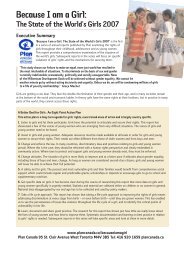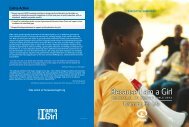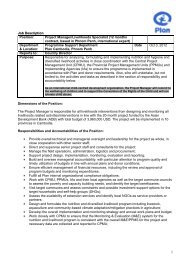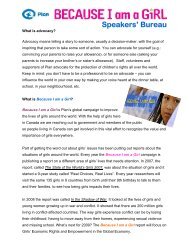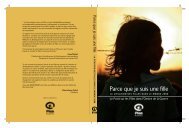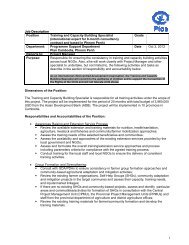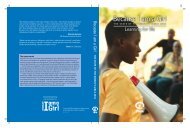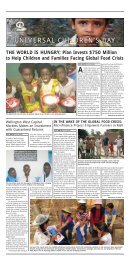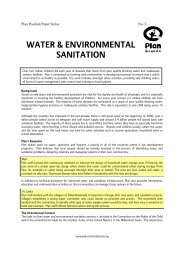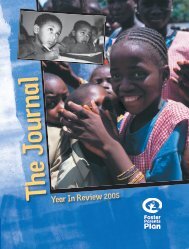Plan Worldwide Annual Review and Combined Financial ...
Plan Worldwide Annual Review and Combined Financial ...
Plan Worldwide Annual Review and Combined Financial ...
You also want an ePaper? Increase the reach of your titles
YUMPU automatically turns print PDFs into web optimized ePapers that Google loves.
i. Investments<br />
Investments that <strong>Plan</strong> has the intent <strong>and</strong> ability to hold to maturity are classified as held to maturity <strong>and</strong> are included in either current or<br />
non-current assets as appropriate. All other investments held by <strong>Plan</strong> are designated as available for sale <strong>and</strong> are included in current assets<br />
unless it is anticipated that they will not be sold within twelve months of the balance sheet date.<br />
Investments available for sale are carried at fair value, whilst investments held to maturity are carried at amortised cost. Realised gains <strong>and</strong><br />
losses arising from changes in the fair value of assets available for sale are included in the combined income statement in the period in which<br />
they are realised. Unrealised gains <strong>and</strong> losses are recorded in a separate category of reserves <strong>and</strong> the amounts arising in the year are recorded<br />
in the combined statement of comprehensive income <strong>and</strong> expenditure.<br />
<strong>Plan</strong> assesses at each balance sheet date whether there is objective evidence that a financial asset is impaired. In the case of equity securities<br />
classified as available for sale, a significant or prolonged decline in the fair value of the security below its cost is considered an indicator that the<br />
securities are impaired. In such cases the cumulative loss is removed from reserves <strong>and</strong> recognised in the combined income statement.<br />
j. Other financial assets – interests in trusts<br />
<strong>Plan</strong> is a beneficiary of certain trusts administered <strong>and</strong> managed by third parties. <strong>Plan</strong>’s interests in these trusts are recorded at fair value <strong>and</strong><br />
classified as current or non-current assets as appropriate.<br />
k. Property, plant <strong>and</strong> equipment <strong>and</strong> intangible assets<br />
Property, plant <strong>and</strong> equipment <strong>and</strong> intangible assets are stated at cost less accumulated depreciation <strong>and</strong> amortisation <strong>and</strong> impairment losses.<br />
Intangible assets represent software held for internal use, which is either purchased, donated or developed internally. Costs relating to software<br />
developed internally are capitalised when the qualifying project reaches the development stage as defined in IAS 38, Intangible Assets.<br />
The cost of assets received as gifts in kind is determined as set out in note 1d. Depreciation <strong>and</strong> amortisation are provided under the<br />
straight-line method over the following estimated useful lives of the assets:<br />
Buildings<br />
5 - 50 years<br />
Equipment<br />
3 - 10 years<br />
Intangible assets:<br />
Purchased software Lower of 5 years or the period of the licence<br />
Other intangibles<br />
3 - 5 years<br />
L<strong>and</strong> is not depreciated. Gains or losses on disposals in the year are included in the combined income statement.<br />
Property, plant <strong>and</strong> equipment <strong>and</strong> intangible assets are subject to review for impairment either where there is an indication of a reduction in<br />
their recoverable amount or, in the case of intangible assets not yet available for use, on an annual basis. Any impairment is recognised in the<br />
combined income statement in the year in which it occurs.<br />
l. Inventory<br />
Humanitarian supplies are valued at cost with obsolete stock written off <strong>and</strong> are included in programme expenditure when distributed to<br />
beneficiaries. Cost comprises the cost of purchase <strong>and</strong> is determined using the first-in, first-out method.<br />
The net realisable value of inventory held for trading activities is the estimated selling price in the ordinary course of business less applicable<br />
variable selling expenses.<br />
m. Non-current liabilities – termination benefits <strong>and</strong> pension obligations<br />
The amount accrued for termination benefits represents <strong>Plan</strong>’s estimated obligation to employees who have an unconditional legal entitlement<br />
to termination benefits, either under local statute or their employment contract.<br />
<strong>Plan</strong> Netherl<strong>and</strong>s <strong>and</strong> <strong>Plan</strong> Norway maintain defined benefit pension plans. The amount recognised in respect of these pension plans represents<br />
the present value of the pension obligations less the fair value of the plan assets, as adjusted for unrecognised prior service costs/benefits<br />
<strong>and</strong> unrecognised actuarial gains/losses. Pension obligations (<strong>and</strong> costs) are measured using the projected unit credit method. For individual<br />
18





